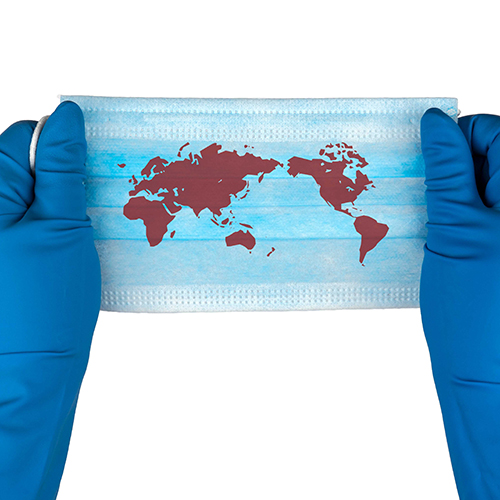01 May 2020
 This week it was revealed that Australia is projected to lose $60 billion as a result of the stringent measures taken to halt the Covid-19 pandemic and prevent the devastating loss of life that has occurred in the UK, Europe, China and the US.
This week it was revealed that Australia is projected to lose $60 billion as a result of the stringent measures taken to halt the Covid-19 pandemic and prevent the devastating loss of life that has occurred in the UK, Europe, China and the US.
Australia has been widely praised for its handling of the pandemic, keeping deaths to below 100, ramping up testing and tracing, and is now on the verge of easing restrictions as infection rates dwindle.
But it has come with enormous financial, social and mental health costs. Up to 3.4 million people have lost their jobs, domestic violence is escalating, and anxiety, depression and loneliness are at an all-time high.
We asked three UniSA academics in the health, economic and philosophical space to give their perspective:
Professor Adrian Esterman (Epidemiologist)
“$60 billion versus 100 deaths is not a fair comparison. Sweden with a population of 10 million has had very few restrictions but 2,355 deaths. If we had taken the same route, we would have something like 6,000 deaths, many of them doctors, nurses and productive people.
“At least we will know now how to respond to the next pandemic when (not if) it arrives and be better prepared economically. Far more people after this outbreak will be working from home, and businesses will now be used to working remotely. Restaurants will increasingly do takeaways and people like hairdressers and fitness instructors will change the way they operate.
“Yes, the pandemic has been terribly destructive economically. But look at the upside. Newstart finally doubled, there is greater social cohesion, homeless people are being housed and there is less pollution.”
Professor Leonie Segal (Health Economist and Social Policy Analyst)
“The cornerstone of containment is testing, contact tracing and strict isolation of cases. South Korea and Vietnam have – like Australia – implemented targeted testing early, as well as stringent tracing and isolation (with more rigour than Australia).
“Sweden neither implemented a testing regime nor shut down their economy. At 244 Covid-19 deaths per million it is performing considerably better than places like the UK (384 deaths/million) or Belgium (>600 deaths/million), while performing worse than say Norway or Denmark. But the Swedish economy is still open, so other consequences have been avoided.
“The UK, and the US were conspicuous in being too late, too slow and inadequate in getting a testing and tracing program in place, with disastrous consequences.”
“The key is to consider which parts of the containment strategy yielded the greatest impact at least cost and which were high cost (direct and immediate as well as unintended and longer term) and potentially made a lower contribution to containment success.
“Getting in early with an effective testing, tracing and isolation is the key. The more draconian elements of the social distancing, not only have massive budgetary cost but will destroy livelihoods, create an environment of uncertainty and fear, and enforce people to work from home regardless of personal or family circumstances.
“It will also result in increased stress and distress, especially in those living on the edge. We only need to see a 10 per cent increase in suicide rates - which I would say is the minimum - to have 300 additional deaths, leaving more children without dads. We also face the risk of escalating family violence and child maltreatment, and later this year more foetal alcohol syndrome births, all with serious consequences across the life course.”
Dr Connal Lee (Philosopher and ethicist)
“What we have here is a classic example of intangible public health benefits. If we had not spent as much money on our pandemic response, the numbers of ill/dead would be much higher. Although the public can be shown the modelling and graphs, they still must put their trust in authorities.
“This is not a new problem of measuring value in public health, but it is also not the same as the health benefits of a public pool or a park or improving sanitation. In these cases, there is something you can grab, look at, and experience. Unfortunately, it might simply be a case of saying 'if we hadn't spent the money you may not be alive.'
“Drawing a comparison with other nations is one effective way to create something that feels physical and real. Looking at the US or the UK experience with their high death toll and overloaded health systems can provide some perspective.
“With the flu season coming, the public will need to be educated about why expected cases will fall (due to social distancing and improved hygiene) but also encouraged to express their concerns, fears and interests.
“This of course raises another classic problem - how to communicate with the public about health. Should we use emotion and even fear (the Grim Reaper HIV/Aids advertisement from the 80's) or should we use reason and raw data.”
Media contact: Candy Gibson office +61 8 8302 0961 mobile: +61 434 605 142
email: candy.gibson@unisa.edu.au
Researcher contacts:
Professor Adrian Esterman mobile: 0401 124 613 email: adrian.esterman@unisa.edu.au
Professor Leonie Segal mobile: 0418 300 805 email: leonie.segal@unisa.edu.au
Dr Connal Lee email: connal.lee@unisa.edu.au



